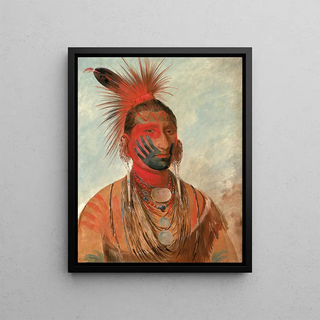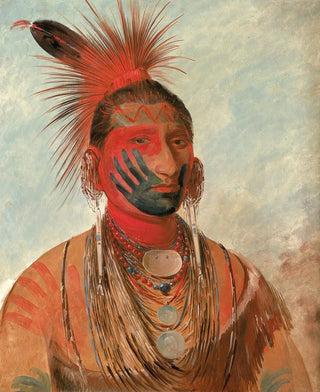Art print | Washkamonya Fast Dancer in Warrior - George Catlin


View from behind

Frame (optional)
The art print Washkamonya Fast Dancer dans Guerrier - George Catlin immerses us in a time when the art and culture of Indigenous peoples of North America intertwine with Western imagination. This iconic piece, created by George Catlin in the 19th century, is much more than a simple visual representation. It embodies a moment of encounter between two worlds, a silent dialogue between the artist and the subjects he immortalizes. Through dance, Catlin captures the very essence of the spirituality and tradition of native peoples, offering a window into a rich and often overlooked cultural heritage.
Style and uniqueness of the work
Catlin's style is distinguished by its realistic approach, but also by its penchant for expressionism. In Washkamonya Fast Dancer dans Guerrier, every brushstroke seems to vibrate to the rhythm of the dance, conveying not only movement but also the energy and fervor that animate the dancer. The vivid colors and meticulous details of the traditional costumes reveal a careful attention to the culture and rituals of the American Indians. The work does not merely freeze a moment; it invites the viewer to feel the intensity of the performance, to perceive the beating of drums, and to immerse themselves in the festive atmosphere surrounding it. Catlin succeeds in capturing a fleeting essence, paying homage to a living tradition while preserving it for future generations.
The artist and his influence
George Catlin, painter and ethnographer, dedicated a large part of his life to documenting Native tribes through his works. His work is marked by a deep admiration for the cultures he encountered, but also by a desire to defend them against colonial expansion. Catlin understood that art could be a powerful vehicle for awareness and preservation. By exhibiting his works in Europe, he helped raise awareness of the richness of Indigenous cultures, while challenging stereotypes and prejudices of his time. His influence endures today, and his works continue

Matte finish

View from behind

Frame (optional)
The art print Washkamonya Fast Dancer dans Guerrier - George Catlin immerses us in a time when the art and culture of Indigenous peoples of North America intertwine with Western imagination. This iconic piece, created by George Catlin in the 19th century, is much more than a simple visual representation. It embodies a moment of encounter between two worlds, a silent dialogue between the artist and the subjects he immortalizes. Through dance, Catlin captures the very essence of the spirituality and tradition of native peoples, offering a window into a rich and often overlooked cultural heritage.
Style and uniqueness of the work
Catlin's style is distinguished by its realistic approach, but also by its penchant for expressionism. In Washkamonya Fast Dancer dans Guerrier, every brushstroke seems to vibrate to the rhythm of the dance, conveying not only movement but also the energy and fervor that animate the dancer. The vivid colors and meticulous details of the traditional costumes reveal a careful attention to the culture and rituals of the American Indians. The work does not merely freeze a moment; it invites the viewer to feel the intensity of the performance, to perceive the beating of drums, and to immerse themselves in the festive atmosphere surrounding it. Catlin succeeds in capturing a fleeting essence, paying homage to a living tradition while preserving it for future generations.
The artist and his influence
George Catlin, painter and ethnographer, dedicated a large part of his life to documenting Native tribes through his works. His work is marked by a deep admiration for the cultures he encountered, but also by a desire to defend them against colonial expansion. Catlin understood that art could be a powerful vehicle for awareness and preservation. By exhibiting his works in Europe, he helped raise awareness of the richness of Indigenous cultures, while challenging stereotypes and prejudices of his time. His influence endures today, and his works continue






